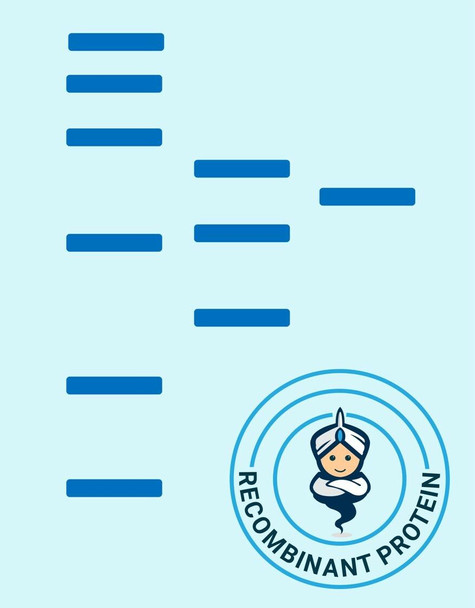Human GPD1L Recombinant Protein (RPPB1731)
- SKU:
- RPPB1731
- Product Type:
- Recombinant Protein
- Species:
- Human
- Uniprot:
- Q8N335
- Research Area:
- Enzymes
Description
| Product Name: | Human GPD1L Recombinant Protein |
| Product Code: | RPPB1731 |
| Size: | 20µg |
| Species: | Human |
| Target: | GPD1L |
| Synonyms: | Glycerol-3-phosphate dehydrogenase 1-like protein, GPD1-L, GPD1L, KIAA0089. |
| Source: | Escherichia Coli |
| Physical Appearance: | Sterile Filtered colorless solution. |
| Formulation: | GPD1L protein solution (1mg/ml) containing 20mM Tris-HCl buffer (pH8.0), 20% glycerol and 1mM DTT. |
| Stability: | Store at 4°C if entire vial will be used within 2-4 weeks. Store, frozen at -20°C for longer periods of time. For long term storage it is recommended to add a carrier protein (0.1% HSA or BSA).Avoid multiple freeze-thaw cycles. |
| Purity: | Greater than 95.0% as determined by SDS-PAGE. |
| Amino Acid Sequence: | MGSSHHHHHH SSGLVPRGSH MAAAPLKVCI VGSGNWGSAV AKIIGNNVKK LQKFASTVKM WVFEETVNGR KLTDIINNDH ENVKYLPGHK LPENVVAMSN LSEAVQDADL LVFVIPHQFI HRICDEITGR VPKKALGITL IKGIDEGPEG LKLISDIIRE KMGIDISVLM GANIANEVAA EKFCETTIGS KVMENGLLFK ELLQTPNFRI TVVDDADTVE LCGALKNIVA VGAGFCDGLR CGDNTKAAVI RLGLMEMIAF ARIFCKGQVS TATFLESCGV ADLITTCYGG RNRRVAEAFA RTGKTIEELE KEMLNGQKLQ GPQTSAEVYR ILKQKGLLDK FPLFTAVYQI CYESRPVQEM LSCLQSHPEH T |
Glycerol-3-phosphate dehydrogenase 1-like protein (GPD1L) converts sn-glycerol 3-phosphate to glycerone phosphate. GPD1L is found in the cytoplasm, associated with the plasma membrane, where it binds the sodium channel, voltage-gated, type V, alpha subunit (SCN5A). Mutations in the GPD1L gene are the cause of SIDS (sudden infant death syndrome) and Brugada syndrome type 2 (an autosomal dominant tachyarrhythmia).
GPD1L Human Recombinant produced in E.Coli is a single, non-glycosylated polypeptide chain containing 371 amino acids (1-351 a.a.) and having a molecular mass of 40.6kDa.GPD1L is fused to a 20 amino acid His-tag at N-terminus & purified by proprietary chromatographic techniques.
| UniProt Protein Function: | GPD1L: Plays a role in regulating cardiac sodium current; decreased enzymatic activity with resulting increased levels of glycerol 3-phosphate activating the DPD1L-dependent SCN5A phosphorylation pathway, may ultimately lead to decreased sodium current; cardiac sodium current may also be reduced due to alterations of NAD(H) balance induced by DPD1L. Defects in GPD1L are the cause of Brugada syndrome type 2 (BRGDA2). An autosomal dominant tachyarrhythmia characterized by right bundle branch block and ST segment elevation on an electrocardiogram (ECG). It can cause the ventricles to beat so fast that the blood is prevented from circulating efficiently in the body. When this situation occurs (called ventricular fibrillation), the individual will faint and may die in a few minutes if the heart is not reset. Defects in GPD1L are a cause of sudden infant death syndrome (SIDS). SIDS is the sudden death of an infant younger than 1 year that remains unexplained after a thorough case investigation, including performance of a complete autopsy, examination of the death scene, and review of clinical history. Pathophysiologic mechanisms for SIDS may include respiratory dysfunction, cardiac dysrhythmias, cardiorespiratory instability, and inborn errors of metabolism, but definitive pathogenic mechanisms precipitating an infant sudden death remain elusive. Belongs to the NAD-dependent glycerol-3-phosphate dehydrogenase family. |
| UniProt Protein Details: | Protein type:Lipid Metabolism - glycerophospholipid; Oxidoreductase; EC 1.1.1.8 Chromosomal Location of Human Ortholog: 3p22.3 Cellular Component: cytosol; plasma membrane Molecular Function:glycerol-3-phosphate dehydrogenase (NAD+) activity; sodium channel regulator activity Biological Process: NAD metabolic process; negative regulation of peptidyl-serine phosphorylation; phosphatidic acid biosynthetic process; regulation of heart rate; triacylglycerol biosynthetic process Disease: Brugada Syndrome 2 |
| NCBI Summary: | The protein encoded by this gene catalyzes the conversion of sn-glycerol 3-phosphate to glycerone phosphate. The encoded protein is found in the cytoplasm, associated with the plasma membrane, where it binds the sodium channel, voltage-gated, type V, alpha subunit (SCN5A). Defects in this gene are a cause of Brugada syndrome type 2 (BRS2) as well as sudden infant death syndrome (SIDS). [provided by RefSeq, Jul 2010] |
| UniProt Code: | Q8N335 |
| NCBI GenInfo Identifier: | 74750945 |
| NCBI Gene ID: | 23171 |
| NCBI Accession: | Q8N335.1 |
| UniProt Secondary Accession: | Q8N335,Q14702, Q9BRM5, A8K9U3, |
| UniProt Related Accession: | Q8N335 |
| Molecular Weight: | 38,419 Da |
| NCBI Full Name: | Glycerol-3-phosphate dehydrogenase 1-like protein |
| NCBI Synonym Full Names: | glycerol-3-phosphate dehydrogenase 1-like |
| NCBI Official Symbol: | GPD1L�� |
| NCBI Official Synonym Symbols: | GPD1-L�� |
| NCBI Protein Information: | glycerol-3-phosphate dehydrogenase 1-like protein |
| UniProt Protein Name: | Glycerol-3-phosphate dehydrogenase 1-like protein |
| Protein Family: | Glycerol-3-phosphate dehydrogenase 1-like protein |
| UniProt Gene Name: | GPD1L�� |
| UniProt Entry Name: | GPD1L_HUMAN |










